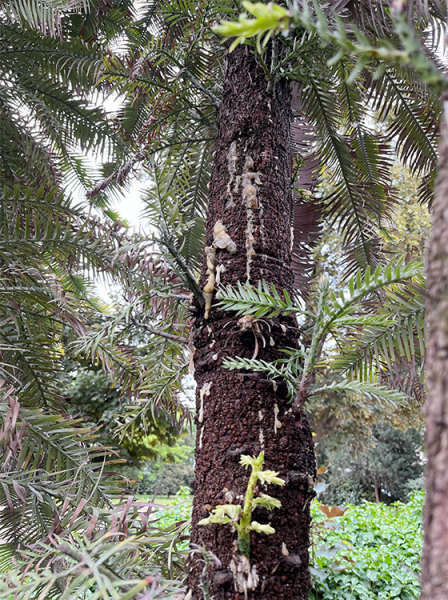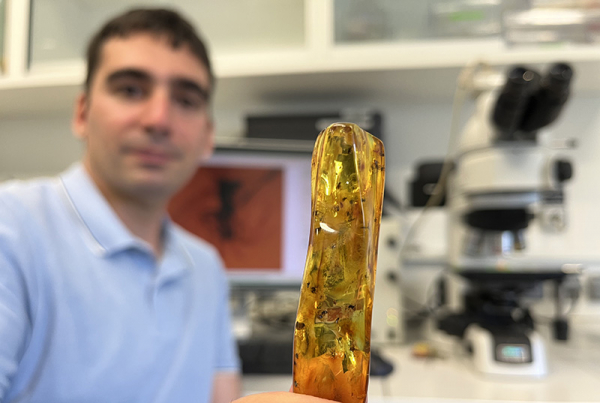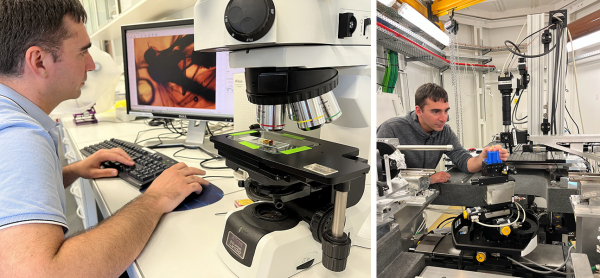Made famous by the book (and films) 'Jurassic Park', the exceptional 3D preservation of amber* inclusions (insects, feathers, plants, etc.) has been the subject of many fantasies, notably the possibility of retrieving DNA from long extinct organisms. Although it is now known that ancient DNA is not preserved in amber, the processes behind its degradation, as well as that of the organisms themselves, remain poorly known. Scientists from the IPANEMA laboratory and PUMA used X-ray microtomography on this beamline to decipher the physico-chemical phenomena involved.
Michael Crichton's inspiration for Jurassic Park came from work published in 1982 by palaeobiologist George Poinar Jr. and his wife Roberta Hess, an electron microscopy specialist. They described exceptionally preserved intracellular structures, including cell nuclei and mitochondria, from a 40- million-year-old insect entombed in amber. Coincidentally, a series of studies reported the discovery of ancient DNA in amber inclusions at the time of the shooting and release of the movie in 1993.
Unfortunately, we now know that in these studies the DNA sequenced was in fact modern DNA, and that even in insects trapped 'recently' in resin (less than 11,000 years ago), all traces of DNA have disappeared. Remains or derivatives of other molecules such as chitin (the main component of the insect exoskeleton) have nevertheless been reported from a series of fossils. Yet many localities only preserve cuticle or hollow molds, or no fossils at all. Why and how does amber allow in some cases for an almost complete preservation of organisms, including some intracellular structures, and in others only their hollow molds? The processes that control this diversity of preservation remain largely unknown.
Recent chemical characterisation studies of amber focused on the resin itself, but very little work has investigated the chemistry of the inclusions, which faces important methodological challenges both because of their three-dimensional appearance and because the resin has largely (if not completely) penetrated the inclusions, mixing up their chemical compositions. So-called "actualistic" experiments**, based on the laboratory embedding of modern insects in fresh tree resin, appear to be the key to unlock the processes controlling the preservation of insects in amber and to identify associated biases. On the other hand, the three-dimensional challenge can be overcome by using synchrotron X-ray microtomography (SR-μCT), a particularly powerful method for observing both the external and internal features of the resin-entombed insect.

Figure 1: Natural resin flows along the trunk of the Wollemi pine located at the entrance of the Paleontology and Comparative Anatomy Gallery of the National Museum of Natural History, which were used to entomb modern fruit flies.
© P. Gueriau
Until now, palaeontologists have mainly used SR-μCT to obtain high-resolution, high-contrast morphological information. However, another type of information provided by this technique has been neglected: the chemical information that lies behind the observed morphological contrasts, related to the density of the materials present and that can be extracted, in a semi-quantitative way, by advanced image calibration and analysis.
Such high-definition experiments were carried out on the PUMA beamline at the beginning of June 2022 by researchers from the IPANEMA laboratory, in collaboration with PUMA scientists. They are aimed at non-destructively characterising, on a submicrometre scale:
- fossil dipteran insects (flies and mosquitoes) trapped in 40-million-year-old Baltic amber
- an actualistic referential of modern fruit flies (Drosophila) embedded in different conifer resins (pine, Wollemi pine and Araucaria), and artificially heated to 150 and 250°C to mimic the temperature changes associated with fossilisation and the origin of different types of amber.

Figure 2: A large piece of 40-million-year-old Baltic amber from Lithuania, containing a dozen flies.
© P. Gueriau & C. Iacconi
Scientists are now comparing the collected data sets, looking for changes both at the morphological level (wilting, disappearance of internal organs...) and physico-chemical level (decrease and/or increase in density showing degradation and/or mineralisation of certain organs) that would be linked to the type of resin and the temperature used. These analyses constitute the first stage of a longer-term project; they will be followed by more detailed chemical characterisation analyses using infrared spectroscopy notably, with the aim of describing precisely the early mechanisms associated to entombment in amber.

Figure 3:
Left: Pierre Gueriau, research engineer at the IPANEMA laboratory and leader of the project, observes with a microscope the state of preservation of one of the modern fruit flies that was trapped in tree resin and then heated to 250°C.
© P. Gueriau & C. Iacconi
Right: A fragment of Baltic amber is mounted on the sample holder of the PUMA beamline.
© P. Gueriau & S. Cohen
* Amber: fossil resin secreted millions of years ago by conifers or flowering plants.
** Actualist experiments: their principle is to test hypotheses about past behavior or processes by reproducing in the laboratory the phenomena studied (here: inclusion in amber) as they might have occurred, using the same materials under the same environmental conditions.
